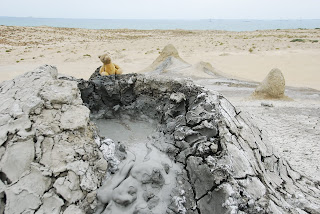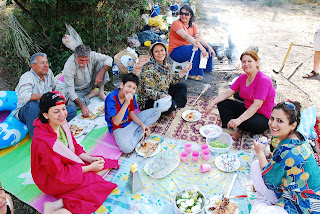Baku, Sunday August 23
I'm back in Baku today, contrary to my original plan. I left five days ago, headed north to the Caucasus mountain town of Xinaliq, hoping to trek over the mountains with a horse carrying my baggage and bike for two days until I reached the road to Georgia. Sadly, it didn't work out and I've been forced to retreat and take the long way around the mountains via Baku; I plan to leave tomorrow morning early. However, it was a good trip, despite the rain, with some impressive mountain views, some exhilarating and exhausting riding, and an amazing ride back into Baku blown by a stiff tailwind.
 My first three days in Baku were absolutely slothful, lounging around Natalya's apartment, reading, eating and using the Internet. On the fourth day, I bestirred myself and rode out to find the Ateshgah fire temple in Suraxani, on the outskirts of the city. I was foiled in my attempt at first by the orgy of road-construction in Baku, which made all my maps out of date. I ended up on the new airport highway, which loops far out to the east before coming back to the airport. By the time I realized my error, it was too late and I got to the airport and doubled back on the old airport road before getting lost again. I ended up in a photogenically decrepit oilfield and took a photo of rusting "nodding donkey" wells pumping away. Five minutes later two policemen came and took me to the local station to yell at me for compromising national security with my photo, so I had to delete the offending snapshot.
My first three days in Baku were absolutely slothful, lounging around Natalya's apartment, reading, eating and using the Internet. On the fourth day, I bestirred myself and rode out to find the Ateshgah fire temple in Suraxani, on the outskirts of the city. I was foiled in my attempt at first by the orgy of road-construction in Baku, which made all my maps out of date. I ended up on the new airport highway, which loops far out to the east before coming back to the airport. By the time I realized my error, it was too late and I got to the airport and doubled back on the old airport road before getting lost again. I ended up in a photogenically decrepit oilfield and took a photo of rusting "nodding donkey" wells pumping away. Five minutes later two policemen came and took me to the local station to yell at me for compromising national security with my photo, so I had to delete the offending snapshot.
After all this, the temple was a bit of a let-down, but it was interesting that despite the Persian name, it was in fact a Hindu temple for long-travelling sadhus. There may have been a Zoroastrian fire temple here once, but not in recorded history. It's one of quite a number of natural fire sources on the Abseron Peninsula, and indeed throughout the region; Joanne and I saw another one, the Chimera, on the Turkish coast last summer. The ride back into town took only 22 km, rather than the 44 km I covered on the way out, and on the way I found a welding shop to repair the small braze-on eyelet that holds my back rack in place and which had sheared off on the way into Baku. The guys in the shop were hilarious, and seem to know how to do a good job welding too.
Leaving Baku on Wednesday, I left ludicrously late (like 11:30 am!) and rode slowly through the post-Soviet post-industrial apocalyptica of Sumqayit, where dozens of petrochemical plants once poisoned the air and water, and which now rusts away in peace. I made it 100 km up the coast, stopping below the sacred mountain Beshbarmaq to camp. The next day I had a slow slog uphill in the rain to Quba, a small pleasant town with (apparently) a Jewish village across the river, and (definitely) the best doner kebabs in Azerbaijan. I cycled another 15 km up the river and camped in a lovely meadow that would have had great views if it had stopped raining.
 After a rainy night, I spent the entire next day riding to Xinaliq, a mere 36 kilometres away. My average speed for the day was a mere 7.4 km/h, which tells you that it was a strictly uphill sort of day. And what uphills they were! The Soviets, when building roads, do not go for any wimpy European or Iranian ideas of what a sensibly steep grade is. The steepest bits are a 20% grade according to my cycling computer, which is like an intermediate ski run. On an unloaded bike, that's doable, but with 40 kg on the bike, I had to abandon all dignity and push the bike up several steep bits, cursing and swearing the whole way. I haven't been on such steep stuff since the jeep tracks of NW Pakistan 11 years ago, and this might have been steeper. At least it was paved! The road led through a spectacularly photogenic gorge straight out of a Chinese scroll painting, and up, up, up through green hillsides distorted into crazy shapes like a Salvador Dali pool table.
After a rainy night, I spent the entire next day riding to Xinaliq, a mere 36 kilometres away. My average speed for the day was a mere 7.4 km/h, which tells you that it was a strictly uphill sort of day. And what uphills they were! The Soviets, when building roads, do not go for any wimpy European or Iranian ideas of what a sensibly steep grade is. The steepest bits are a 20% grade according to my cycling computer, which is like an intermediate ski run. On an unloaded bike, that's doable, but with 40 kg on the bike, I had to abandon all dignity and push the bike up several steep bits, cursing and swearing the whole way. I haven't been on such steep stuff since the jeep tracks of NW Pakistan 11 years ago, and this might have been steeper. At least it was paved! The road led through a spectacularly photogenic gorge straight out of a Chinese scroll painting, and up, up, up through green hillsides distorted into crazy shapes like a Salvador Dali pool table.  After the last pass, I rode up a mercifully flattish valley with two road maintenance workers, drank tea with them and then pushed up the cruel final uphill into Xinaliq town, feeling glad that I'd donned my long tights and Gore Tex jacket for the first time this trip: it was cold!!
After the last pass, I rode up a mercifully flattish valley with two road maintenance workers, drank tea with them and then pushed up the cruel final uphill into Xinaliq town, feeling glad that I'd donned my long tights and Gore Tex jacket for the first time this trip: it was cold!! I quickly discovered that my hike wasn't going to happen. You must, by law, take a guide and the guides, with a monopoly, gouge tourists mercilessly, asking for crazy sums of money. The cheapest offer I got was for $500 for 2 days' walking across the mountains to Laza. I would never pay that, and the incessant rain made it a bit of a moot point anyway. I absorbed what views I could between the rainclouds, put up my tent and cooked up a huge meal.
I quickly discovered that my hike wasn't going to happen. You must, by law, take a guide and the guides, with a monopoly, gouge tourists mercilessly, asking for crazy sums of money. The cheapest offer I got was for $500 for 2 days' walking across the mountains to Laza. I would never pay that, and the incessant rain made it a bit of a moot point anyway. I absorbed what views I could between the rainclouds, put up my tent and cooked up a huge meal. The next day (yesterday) I awoke to more rain, did some bike maintenance (changing disk brake pads for the first time ever: a fiddly job!) and then, when the rain had stopped, rode back to Quba, making it there in time for another doner kebab lunch. I left at 3 pm, hoping to make a few kilometres back towards Baku. And I did: about 110 of them in the next 4 hours, flying along on a downhill (at first) and a fantastic tailwind (later). It's been a long time since I made so many kilometres so effortlessly. I camped out 60 km from Baku, and was in town today by noon, ready for more loafing and Internet. Tomorrow, the road to Georgia awaits, and I should be at the border in 4 more days. Insh'Allah.
The next day (yesterday) I awoke to more rain, did some bike maintenance (changing disk brake pads for the first time ever: a fiddly job!) and then, when the rain had stopped, rode back to Quba, making it there in time for another doner kebab lunch. I left at 3 pm, hoping to make a few kilometres back towards Baku. And I did: about 110 of them in the next 4 hours, flying along on a downhill (at first) and a fantastic tailwind (later). It's been a long time since I made so many kilometres so effortlessly. I camped out 60 km from Baku, and was in town today by noon, ready for more loafing and Internet. Tomorrow, the road to Georgia awaits, and I should be at the border in 4 more days. Insh'Allah.
Peace and Gale-Force Tailwinds
Riding Day No.
|
Date
|
Distance
From Bushehr
|
Daily
Distance
| Final Elevation |
Vertical
Metres
|
Cycling
Time
|
Average
Speed
|
Maximum
Speed
| Daily Destination |
27
| 8/19 | 2793.1 | 98.0 | 0 | 441 | 5:35 | 17.6 | 41.9 | Beshbarmaq |
28
| 8/20 | 2886.6 | 93.5 | 968 | 1280 | 6:46 | 13.8 | 28.3 | Qacras |
29
| 8/21 | 2925.2 | 38.6 | 1952 | 1919 | 5:03 | 7.6 | 40.1 | Xinaliq |
30
| 8/22 | 3081.4 | 156.2 | 18 | 866 | 7:13 | 21.7 | 51.5 | Sitalcay |
31
| 8/23 | 3142.2 | 60.8 | 0 | 319 | 2:42 | 22.6 | 47.9 | Baku |






























